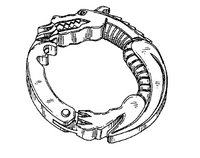
Design patents in the United States are intended to protect the ornamental or decorative features of a product. The idea is pretty simple- your product has decorative features that you don't want anyone to copy, so you get a design patent showing your product with those features. Here is an example:
That is a carabiner shaped like a dragon. The existence of this patent doesn't stop anyone from making and selling carabiners that look like dragons, but it prevents us from making and selling carabiners that look like the product on the right.
But in fact, design patents are the most abused kind of U.S. patent. For example, Johnny McNutbat is trying to sell his perpetual-motion time-travelling weedwhacker, and he files for a design patent on it. Then he tells all his potential customers at the Homeopathy and Healing Crystal Convention that the product is 'Patent Pending'. Since the USPTO doesn't even try to examine design patents any more, and pretty much just stamps 'em on through, Johnny's Energizing Cross-Temporal Eater of Weeds is soon 'patented'.
But that's not the only kind of abuse. Even though design patents are intended to protect only ornamental designs, there exist all kinds of design patents that have no ornamental features whatsoever. There is no obligation tell the USPTO what the ornamental features are, the inventor just submits drawings. So companies and individuals pack all kinds of purely functional features into their designs, and grab a design patent. So for example, you can find design patents for things like diodes and ratchet wheels.
To determine whether a product infringes a design patent, they use something called the 'ordinary observer' test. The ordinary observer is like an average consumer- and if it's believed that the average consumer would buy the infringing product thinking that it was the patented product, then infringement has occurred. But, the confusion has to have arisen from the fact that the infringing product has the 'points of novelty' shown in the patent. There are a lot of problems with this approach. I'd guess that for more than half of the design patents registered today, there is no corresponding product on the market that is produced or sold by the patentee. So how could an ordinary observer be confused? His only point of reference is the (allegedly) infringing product.
Given all this (And I know it's sloppy. Google "design patent" if you want to know more), tell me- Does this product:

Infringe this design patent?

Answers that I agree with would be appreciated.


11 comments:
Looks the same to me and my tool lovin' husband. Hope that's the right answer.
Karl, you left off the other reason there are so many bogus design patents: there are companies in the US that claim to "inventors" that they will patent their invention for them cheaply, and do so by applying for design patents.
Not the same. One is a real live wrench, and the other is a cartoon. And they're pointing different directions.
Seriously, the interior of the boxed end is different. (The picture of the cartoon wrench doesn't indicate any different material inside.) Can't really tell about the number of "teeth".
Even more nitpicky, the open end of the cartoony wrench seems to be in line with the body of the wrench, whereas the real-live one's open end is slightly angled.
When it's all said and done, I'd never buy a cartoony wrench, because they're flimsy.
Malv, I think you missed your calling. You're good at this. You'd probably piss of judges though.
Robin, I didn't about those kind of companies. That's pretty cheesy.
Also, the wrench on the top has a cool moebius-strip look to it, while the wrench on the bottom looks like somebody took two wrenches, cut them in half, and fused them together at a 90-degree angle.
Plus the top one has a fierce-looking ring of black teeth in the box end, while the bottom wrench's teeth look like their made out of the same stuff as the rest of the wrench.
PS: Sorry I didn't respond to your e-mail from a couple of months ago. It's been a busy summer. I'll go do that now.
Now, you are probably more expert than me in this area, but I thought that it's considered a copy unless there are three points of difference. (That's what one customer said you needed to have to beat a design patent.)
Yes, the product is infringing. It looks the same from a consumer point of view.
Regarding the general issue of putting function into a design patent (like design patenting the most efficient design of a part so that any competitor must use a less efficient deisgn) I think it's all fair in love and war. So far, I am losing the war, but what the hell.
Why the hell would anyone want a carabiner shaped like a dragon anyway?
For climbing Yulong Mountain?
One wrench has magnetic features that permit the wrench to hold nuts and washers.
The dragon carabiner is cool.
Mr. Karl. How has the increased use of rubber gloves by auto mechanics affected tool design?
Mr. Anonymous, the wrench in the photo does not have a magnetic feature. It has a ratcheting gear ring in the box end, which was noted by Malv as looking like a different material. (Actually, I think it is the same material with different plating)
Kevlar, on our side there have been no design changes based on the increasing use of gloves by mechanics. If you have any ideas, I'd be happy to hear them. If you have any *patentable* ideas, I'd be ecstatic to hear them, and will pay you tens and tens of dollars in compensation.
Post a Comment